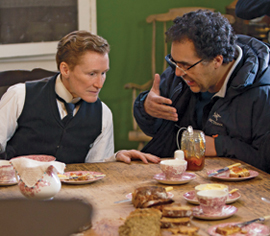By Margy Rochlin

MINIMALIST:
Garcia learned from working with Mike
Nichols "how much you can direct by directing very little."
It wasn't until 1996 that Rodrigo Garcia began toying with the idea of directing. At the time the Colombia-born, Mexico City-raised 39 year old with a cinematography degree from the American Film Institute was working as a camera operator on Mike Nichols' The Birdcage. As he peered through the lens, Garcia couldn't help but be drawn in by the dynamic of what was happening just a few feet away from him. "When you're a camera operator, you're very close to the action," says Garcia who, two years later, found it similarly pulse-quickening to observe director Robert Benton collaborating with Paul Newman and Susan Sarandon on the mystery-thriller Twilight. "I started getting more and more interested in what the actors were doing and the conversations they were having with the director," says Garcia, who was intrigued by how different Nichols and Benton were from the bombastic stereotype of the dictatorial taskmaster who treats the cast like cattle.
"What really mattered to them was the story, the characters. They had great love for the actors, and performances meant a lot to them," says Garcia, who saw what kind of results Nichols and Benton got with their gentle less-is-more approach. "They had what seemed to me a very simple way of working: I would look at Nichols and was surprised by how little he would say to the actors. He relied on the script and the casting and the work that actors would do by themselves. That was astonishing to me: how much you can direct by directing very little."
Over the span of the next couple of years, Garcia began writing a script to direct himself. Called Things You Can Tell Just by Looking at Her, it was a series of short dramatic segments that occasionally overlapped. Made for a spare $2 million and shot on location in Los Angeles' San Fernando Valley, it tracked the lives of five women in what Garcia refers to as "miniatures," or short, intense portraits brimming with details of each character's life. Displaying what are now considered signature Garcia touches—a leisurely pace, a subdued tone, and carefully composed, beautifully lit shots—it also contained the kind of economical camera moves of which his cinematographer heroes would have approved.
"Everything flashy is antithetical to guys like Sven Nykvist and Gordon Willis," says Garcia, who'd worked as a camera operator for the great Mexican cinematographer Emmanuel Lubezki and later hired him to shoot Things You Can Tell Just by Looking at Her. "A guy like Gordon Willis wouldn't move the camera unless it needed to move. That's what interested me as a cinematographer and it's what interests me as a director."
Things, which won the Un Certain Regard award at Cannes in 2000, also featured richly observed performances by a cast of big-name stars working for thousands of dollars lower than their usual quote. What all indie filmmakers know is that marquee actors help producers attract the financing, and Things contained a surplus of them including Holly Hunter, Cameron Diaz, Calista Flockhart, Amy Brenneman, and Kathy Baker. The trick to attracting an A-list cast, Garcia insists, boils down to two essentials: a tight script and Glenn Close. The award-winning Close, who has appeared in many of Garcia's films including the upcoming Albert Nobbs, was the first to agree to appear in Things and thereby generated a "who-is-this-guy-and-how-did-he-attract-Glenn-Close?" buzz in Hollywood.
Garcia says it is a "necessity for indie filmmakers to always be thinking, 'Who could it be that would help me get my movie made?'" So what was going through his mind when he visited Close on the set of the TV movie Sarah, Plain and Tall in Kansas, thinking he was still courting her for the film? She waved over co-star Christopher Walken, Garcia recalls, and said, "'I want you to meet Rodrigo. He wrote a beautiful script and I'm going to be in the movie.' I remember thinking, 'I'm going to pass out right now. … I thought, 'It'll be downhill from here.'"
Since then, Garcia has made seven independent features—including Ten Tiny Love Stories, Nine Lives, and Mother and Child. With the exception of Passengers, a $25 million romance-mystery starring Anne Hathaway, Garcia has continued to specialize in labor of love projects that concentrate on grown-up issues, working with tight budgets and restrictive shooting schedules. Mother and Child, for example, which boasted Naomi Watts, Annette Bening, and Kerry Washington as the headlining cast, was shot in 29 days in 2009 for $4.8 million gathered from private investors. But he has worked on even less money and says he discovered, "it's painful, but it can also free you."
Back in 2002, Garcia made Ten Tiny Love Stories for a spare $100,000 and treated it as a creative experiment. The 10 actresses in the cast were informed beforehand that there would be no pre-filming discussion, no rehearsal, and that their wardrobe would consist of whatever they brought from their home closets. "I didn't want to tell them, 'This is what it means,'" says Garcia. Shot entirely in Sony Hi-Def, the film consisted of cast members, filmed one at a time, as they curled up in an overstuffed chair or sitting in a cluttered kitchen, each barely moving as they delivered a monologue directly into the camera touching on a facet of romance, both its hopes and failures. "I wanted to hear the actresses' take," he says.

TURNING TABLES:
Garcia directs Glenn Close as a
starched-collar male hotel butler in Albert Nobbs. "It's
still the story and psychology that carries the movie."
What shoestring budgets have taught Garcia is that to get the daily footage he requires, he needs to arrive on the set as organized and prepared as possible. "I don't like working in chaos," says Garcia, who learned to be super disciplined from his regular TV gigs that bring in money between film projects and allow him to sustain his career as an independent filmmaker. Directing pilots for HBO's Big Love and In Treatment, as well as episodes of series such as The Sopranos and Six Feet Under, has also given Garcia the opportunity to get experience directing actors on studio sets, which are too costly to construct for an average indie. For all the ways that Garcia's Albert Nobbs was an atypical project for him—the script was written by Close and John Banville (not Garcia), it was shot on location in Dublin (not Southern California), and was set in the 19th century (not modern day)—it was his five-episode gig on HBO's bizarre Depression-era soap Carnivále that helped him find a foothold.
"It was like when I did Carnivále and thought, 'Oh, my God, 1930s? Where am I?'" says Garcia of his initial discomfort with Nobbs, a period costume drama about a woman (Close) who passes herself off as a starched-collar-and-dress-suited male hotel butler. "Ultimately you want the wardrobe to be good and help sustain the characters. But it's really the story and the psychology. That's what carries the movie."
It was during preproduction, though, when Garcia, a member of the DGA's Independent Directors Committee, called fellow committee member Kimberly Peirce, director of the similarly gender-disguising Boys Don't Cry, to get advice on how to bring as much masculine credibility as possible to Close's performance. "Body language," is how Garcia sums up Peirce's advice. "She gave me tips about what to look for—how men sit down as opposed to women, how they walk—things to look for physically that were very helpful when I was watching Glenn's performance—not that Glenn needed much watching."
Garcia's latest project is Wigs, a Web series that will be made up of 12 six-minute segments, each centered on the life of a different woman. In Garcia's world, cable television and the Internet have been nothing but welcoming while the film industry seems increasingly disinterested in delicate, serious fare—what he calls "movies for grown-ups"—and he is starting to recalibrate his thinking.
"Theatrical release is always the frontier. If you don't get theatrical release, something failed: You failed, your movie failed or you were just unlucky," says Garcia, adding that two members of the Garcia house-hold are just as happy to watch movies on a laptop or on their iPhones as at the multiplex. "My daughters, who are teenagers, don't have that prejudice that a movie must be on a big screen to be worthy. They're just as thrilled by stuff that they see on Netflix Instant or YouTube," he says.
Garcia suddenly smiles. "But I still think seeing a movie on a big screen is beautiful."